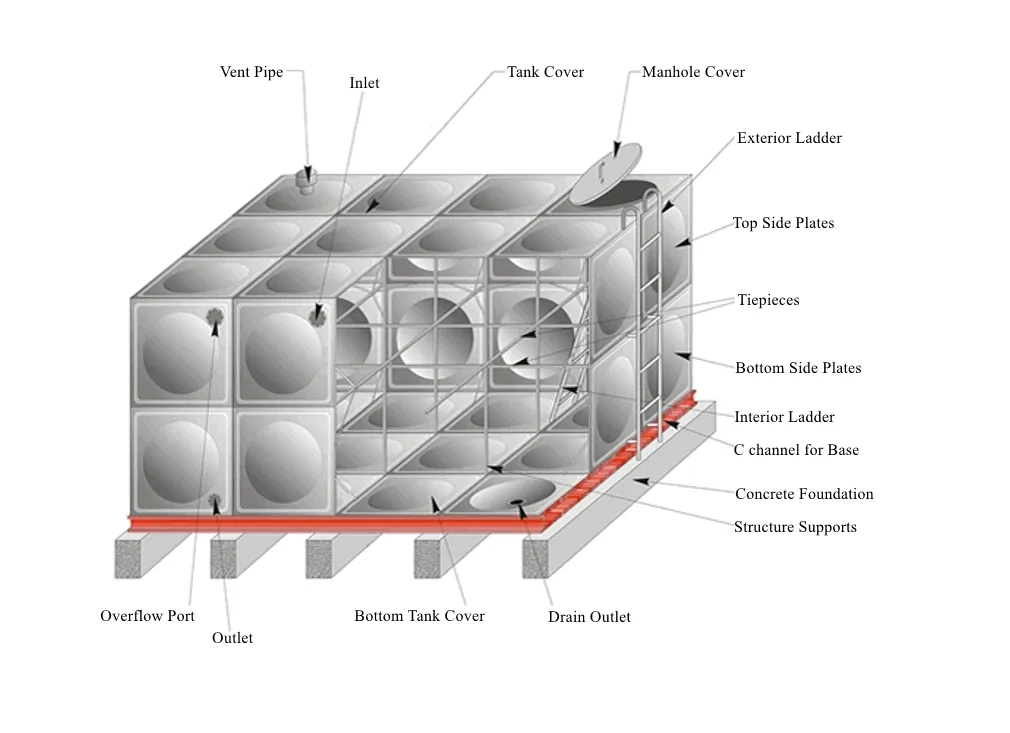loading...
- No. 9, Xingyuan South Street, Dongwaihuan Road, Zaoqiang County, Hengshui, Hebei, China
- admin@zjcomposites.com
- +86 15097380338
- Welcome to visit our website!
Exploring the Advantages and Applications of Sectional Steel Water Storage Tanks in Modern Infrastructure
The Advantages of Sectional Steel Water Tanks
Sectional steel water tanks have gained significant popularity in various applications, particularly for their exceptional durability, modular design, and cost-effectiveness. These tanks are increasingly being used in industrial, commercial, and residential settings for water storage, and their benefits are important to understand.
One of the primary advantages of sectional steel water tanks is their modular construction. Unlike traditional welded tanks that are built as a single unit, sectional tanks are constructed from pre-fabricated panels that can be easily transported and assembled on-site. This modularity is particularly beneficial for locations with limited access or where space constraints make it difficult to fit larger, single-piece tanks. The ability to transport individual sections means that they can be delivered to remote locations with ease, making them an ideal choice for rural and hard-to-reach areas.
Durability is another key feature of sectional steel water tanks. Constructed from high-quality steel, these tanks are resistant to corrosion and wear, ensuring that they can withstand harsh environmental conditions, including extreme temperatures and heavy rainfall. Properly galvanized or coated, these tanks can have an extended lifespan, often exceeding several decades. This durability not only reduces the need for frequent replacements but also ensures that water quality is maintained, as steel can be treated to minimize contamination.
In terms of cost-effectiveness, sectional steel water tanks often present a more economically viable solution than other types of storage options. The ability to customize the size and volume of the tank according to specific needs can help reduce unnecessary expenditures, as organizations pay only for the capacity they require. Furthermore, the reduced installation time and lower transportation costs associated with sectional tanks also contribute to overall savings. For businesses and municipalities looking to manage their budgets effectively, these tanks offer a financially prudent solution.
sectional steel water tanks

Another notable benefit of sectional steel tanks is their versatility. They can be used to store a variety of liquids, including potable water, wastewater, and chemicals. This flexibility makes them suitable for a wide range of industries, including agriculture, manufacturing, municipal utilities, and firefighting services. Additionally, sectional tanks can be designed to comply with local regulations regarding water storage, ensuring that they meet health and safety standards.
Maintenance of sectional steel water tanks is relatively straightforward. Regular inspections and minor repairs can be performed easily, extending the lifespan of the tank. Many manufacturers offer maintenance plans and support, ensuring that users have access to expertise to address any potential issues that arise over time. This focus on durability and ease of maintenance aligns well with the long-term water storage needs of many organizations.
Moreover, sectional steel water tanks are not only functional but can also be aesthetically pleasing, as they can be coated or painted in various colors and finishes to blend into their environment. This consideration is particularly important for community settings where visual appeal plays a role in public acceptance and integration within the landscape.
In conclusion, sectional steel water tanks offer a plethora of advantages, making them a popular choice for water storage solutions. Their modular design allows for easy transport and assembly, while their durability ensures a long life with minimal maintenance. Cost-effective and versatile, these tanks cater to a wide range of industries, proving to be an invaluable asset for managing water resources effectively. As demands for reliable and sustainable water storage continue to grow, sectional steel water tanks stand out as a robust solution.
-
The Rise of FRP Profiles: Strong, Lightweight, and Built to LastNewsJul.14,2025
-
SMC Panel Tanks: A Modern Water Storage Solution for All EnvironmentsNewsJul.14,2025
-
GRP Grating: A Modern Solution for Safe and Durable Access SystemsNewsJul.14,2025
-
Galvanized Steel Water Tanks: Durable, Reliable, and Ready for UseNewsJul.14,2025
-
FRP Mini Mesh Grating: The Safer, Smarter Flooring SolutionNewsJul.14,2025
-
Exploring FRP Vessels: Durable Solutions for Modern Fluid HandlingNewsJul.14,2025
-
GRP Structures: The Future of Lightweight, High-Performance EngineeringNewsJun.20,2025
